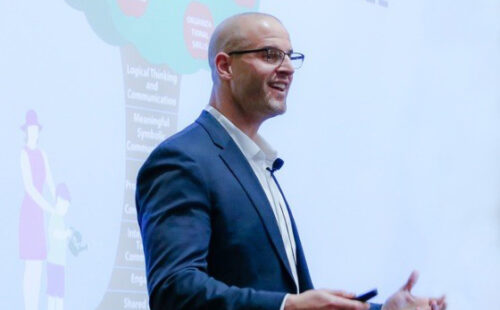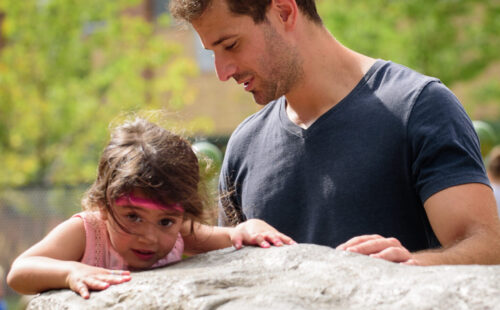“When a child is upset, logic often won’t work until we have responded to the right brain’s emotional needs. We call this emotional connection ‘attunement,’ which is how we connect deeply with another person and allow them to ‘feel felt.’ When parent and child are tuned in to each other, they experience a sense of joining together.” –Dr. Daniel J. Siegel, MD (The Whole-Brain Child: 12 Revolutionary Strategies to Nurture Your Child’s Developing Mind, Survive Everyday Parenting Struggles, and Help Your Family Thrive)
What is attunement, and why is it important?
Attunement is being aware of and responding to the emotions of another person and is the process by which we form close relationships. It is that essential component that allows us to feel close and connected to others. Children need attunement from their caregivers to feel safe and secure, which leads to a strong foundation for their overall development. When a caregiver “tunes in” to a child’s emotional state and is “in it” with them, the child is better able to feel understood, acknowledged, and accepted in that moment. When a caregiver can accept their child as they are and show compassion for their emotional experience, they also begin to lay the groundwork for the child to learn how to be compassionate and empathic toward others.
What does attunement look like?
Attunement and emotional communication start at birth. By paying careful attention to a child’s vocalizations, facial expressions, and body language, caregivers can try to understand what the child needs or is feeling. When a caregiver responds immediately to a child in a calm and nurturing manner, the child feels safe and cared for. Through these repeated interactions, a child also starts to develop trust in others and the understanding that they can rely on people for help. Caregivers often attune to their baby by responding to their basic needs. For example, in response to seeing their baby cry, a caregiver might recognize the baby is hungry, pick up the baby, and then talk in a calm and soothing tone as they feed them.
As a child moves into toddlerhood, other aspects of attunement become important: matching or “mirroring” a child’s emotional experience, labeling the emotion, and validating it. These aspects of attunement help children start to make sense of their internal emotional experiences, while simultaneously feeling supported and less alone because their caregiver is “in it” with them. During toddlerhood and the preschool years, children especially need support with strong emotions such as anger and frustration. For example, if a child gets frustrated while sharing toys, a caregiver might say, “You are frustrated. It can be really hard to share your toys.” It is important that the caregiver matches this statement with a facial expression that reflects the child’s emotion. This helps the child understand that the caregiver “gets” their current emotion and is on the same emotional wavelength. If the caregiver were to smile while delivering this same statement, the child might feel confused or even get more upset.
When trying to attune to another, it is important to remember that so much of emotional communication is non-verbal. We can communicate a lot through tone of voice, facial expressions, gaze, and body posture. Words matter less.
What are “mis-attunement,” rupture, and repair?
Because no caregiver is perfect, there will inevitably be times when they miss a signal or respond in a way that is a mismatch to what the child needs. This is known as “mis-attunement” or a “relationship rupture.” The good news is that when a caregiver strives to be attuned to their child as much as possible, these relationship ruptures (when accompanied by repair) can actually help children develop the capacity for navigating the unavoidable rupture-and-repair process inherent in staying in relationship with others.
Repair in relationship can take many forms depending on the age of the child. For infants, it might take the form of physical contact/closeness. For example, after accidentally startling their baby while playing peek-a-boo, a caregiver might pick up the child to soothe them. This is an act of repair. For older children, repair might involve an apology from the caregiver. For example, after seeing their child kick a piece of furniture in anger, a caregiver might apologize for raising their voice in frustration,
In order to repair the relationship and move back into a state of attunement, it can be helpful to first start with trying to move into a state of curiosity. This can help a caregiver tune into what is going on in their internal state, as well as what is going on in the child. Mis-attunements can often arise when caregivers lack self-awareness (and therefore self-management) of their own internal state. It can be hard to respond to a toddler having a meltdown if the caregiver is not able to first manage their own feelings of frustration so that they are able to respond with a calm demeanor. Staying curious can also be helpful in trying to understand an underlying emotion or need a child is struggling to communicate. Once the caregiver recognizes that a rupture has occurred, they can move into repairing the emotional connection with empathy, compassion, and acceptance.
For more information on St. David’s Center’s parent-child services, go to: www.stdavidscenter.org/homevisiting
JoAnna Van Otterloo, MA, LPCC, is the Program Director of the Early Childhood Home Visiting and Parent-Child Therapy Programs. JoAnna is a certified Attachment & Biobehavioral Catch-up (ABC) training supervisor and Parent Coach. She is also rostered in Child-Parent Psychotherapy (CPP) and has training in Circle of Security Parenting Program (COS-P) and in the Parents as Teachers (PAT) Home Visiting Model. JoAnna’s experiences and interests include providing reflective supervision and in providing therapy that focuses on supporting and strengthening the parent-child relationship, particularly in families with children in the 0-6 age range.

